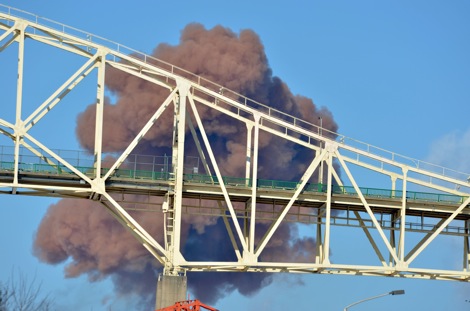 It's called a fuel-coolant interaction when molten steel meets water.
It's called a fuel-coolant interaction when molten steel meets water.
The result is a massive and violent explosion of steam and fragmented bits of slag.
That's what happened twice at Essar Steel Algoma twice in the past year.
The first time was in July at #7 blastfurnace and the second was today at the slag pits west of the mill.
As loud and dramatic an event as the steam explosion is, it's not really a danger to anyone - unless they are very close to the site of that explosion.
"Red clouds (iron oxide fumes) are commonly seen when a steel vessel is filled out (molten iron added to vessel) or when a torpedo (iron track vessel) is dumped on the ground for various reasons," says a reader who has retired from Essar Steel Algoma. "This can be dangerous during wet weather as has been pointed out, any molten metal be it iron, slag or steel could cause various degrees of explosion when dumped onto water."
"Those who work around these conditions are well aware of these conditions and take proper precautions."
So what are people concerned about?
First, it's the sound and the fact that its source is unknown.
"Sunday Morning 11 a.m. a blast somewhere near the westside of the steel plant area," wrote one loyal SooToday.com reader. "Shook my house, on Chippewa, shook my dads house on St. Patricks street followed by a plume of smoke."
"It was soooooo loud I watched three dogs run down my street like the fear of God was in them."
Then there is alarm about the smoke.
Why is it reddish, orange?
Can it hurt me if I breathe it?
While the second question is harder to answer the answer to the first question is the same as the answer to the question, what happens when hot slag hits water?
Basically, a bubble forms around the water and under the slag as it almost instantly turns to steam in a violent and dramatic reaction.
As the hydrogen and oxygen molecules in the water are torn apart energy of almost nuclear proportions is released in a fraction of a second.
"The radial motion of the explosion bubble, including the total energy release, are uniquely determined by a single parameter—the bubble period," says a study of Thermal explosions resulting from fuel-coolant interactions. "Nearly all of the heat transfer from fuel to coolant occurs during the 10-to-the-fifth to 10-to-the-fourth second timespan of coolant vapor film collapse during which the fuel fragments."
In the case of today's explosion, the fragmenting fuel would be slag - a byproduct left over when iron is removed from iron ore to be made into steel.
This slag is largely composed of oxides and silicon dioxide with minute particles of iron residue.
Iron that turns reddish orange when it combines with oxygen, as in rusts.
The cloud of smoke released from the explosion at the Transwest slag dump was dramatic at first but very quickly disipated in the morning breaze.
It did make for some interesting photos, though.